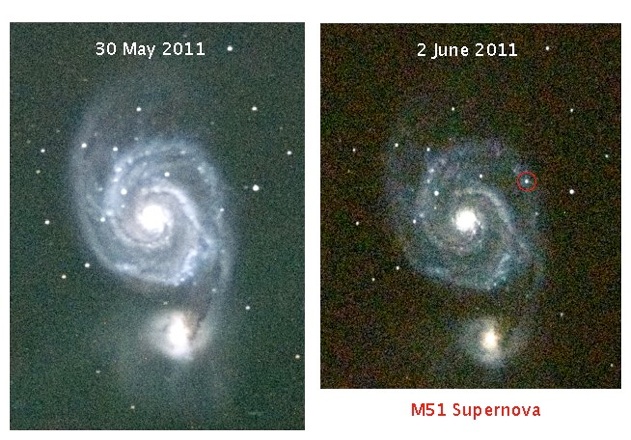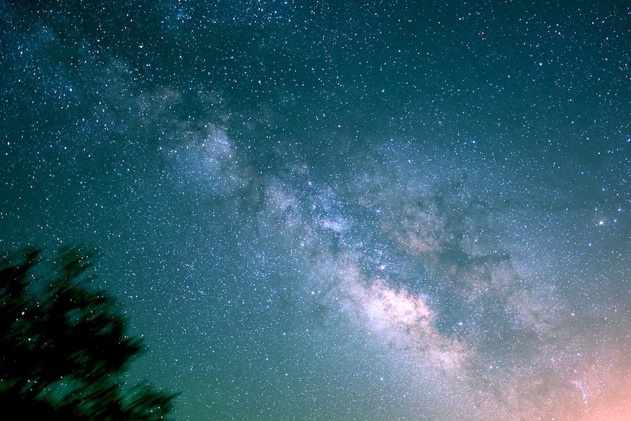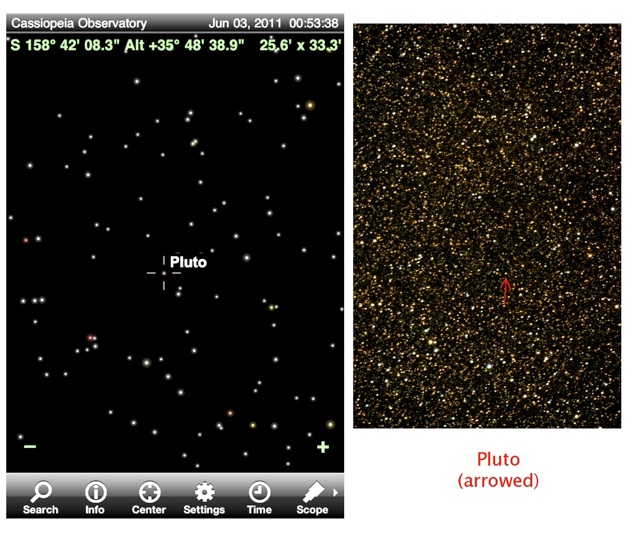
Javelina, M51 Supernova, Milky Way, Pluto
Tuesday, 31 May, dawned with the cloudy skies from the previous night, and some wind (gusts to 21 MPH). Cloudy skies and wind (gusts to 21 MPH) continued until Thursday, 2 June, when the sky began clearing and the wind calmed down in the morning. The wind picked back up again in the afternoon with gusts to 26 MPH. But as sunset approached, the wind died down and I headed out to the observatory. On my way I saw three javelina (wild pigs), probably two parents and their child. This is the first time I have seen them here. The photo above shows one of the parents (left) and the child (right).
The observatory was opened at 1826 MST, 96°F. There were some clouds low along the western horizon. I began trying to see the 1.1 day old crescent moon, but it never became visible, probably due to the clouds.
While waiting for the sun to set, I began comparing my 30 May image of M51 to other pre and post discovery supernova images on my iPhone from inside the observatory. At first, I thought I had captured the supernova! Later, I decided I did not capture it, although two fellow astronomers on Twitter thought I did. I decided to take a comparison image of M51 this night.
Beginning at 1936 MST, I began viewing Saturn with 26mm, 15mm, and 9.7mm eyepieces. As the sky darkened, I observed its moons appearing, finally seeing Titan, Dione, Rhea, Tethys, and Iapetus by 2017 MST.
I then began doing some work with SkySafari 3 Plus and SkySafari 3 Pro for my upcoming reviews. (You can read my review of the basic version of SkySafari 3 on my ETX Site.) I wanted to test these versions with the SkyFi Wi-Fi adapter, but first I had to replace the batteries in the SkyFi. And I probably did a very dumb thing. I replaced the dead batteries with a new set of rechargeable batteries. As I previously mentioned, I had noticed a decreasing lifespan for two other sets of rechargeable batteries. When recharging all three sets, I noticed that the recharger became very hot. I contacted the manufacturer, who has agreed to check out the recharger and batteries. I probably should have stopped using the batteries at that point but didn’t. I successfully used the SkyFi on the rechargeable batteries and did my SkySafari 3 testing for about 15 minutes. Shortly afterwards when I went to turn off the SkyFi, it was very hot, its power-on LED was off, and there was a smell of burnt component! Grrrr! I have now stopped using the rechargeable batteries in the Wireless AutoStar II until the situation with the recharger and batteries is resolved.
At 2120 MST, I began my imaging of M51, the Whirlpool Galaxy, with the D7000 DSLR at prime focus + Off-Axis Guider (OAG). I didn’t try for a guide star as I knew the M51 supernova was fairly bright. I was able to image it with a 1 minute, ISO 6400, unguided exposure. Here are my 30 May and 2 June M51 images. The supernova is circled on the 2 June image.

In reviewing my 30 May image, I have determined that the supernova had not yet occurred. Discovery was announced on 2 June. For more on the supernova, see this article at Sky & Telescope.
At 2150 MST, I began trying to visually observe the M51 supernova with the 8” LX200-ACF. With the 26mm eyepiece (77X), I thought I could just see the supernova. With the 15mm (133X) and averted vision, I was more confident that I was actually seeing it at 2157 MST. I switched to the 9.7m (206X) eyepiece; I could still see what I believe was the M51 supernova.
At 2225 MST, I began a series of Milky Way piggyback images with the D7000. At 0005 MST, I captured this view with a 5 minute, unguided, ISO 500, f/3.5, 18mm focal length, exposure:

(Sky glow in the lower right corner is from Oro Valley and Tucson and looks worse than it actually is.)
At 0020 MST, I began my attempt to see the planet Pluto with the 8” telescope. (Yes, I’m a traditionalist and still consider Pluto to be a planet.) I used SkySafari 3 Pro to identify stars in the field of view and star hop to Pluto’s position. I used a visual back (to match up with the SkySafari view) and the 26mm eyepiece. At 0100 MST, I believe I was able to see Pluto with averted vision. However, it will be necessary to view it again another night to confirm motion. I then set up for prime focus + OAG imaging of Pluto. This comparison image, SkySafari 3 Pro screen shot on the left and my 5 minute, ISO 1600, guided exposure on the right, shows Pluto, or at least what I believe to be Pluto, based on SkySafari’s database.

The image scales and orientation are essentially the same. See if you can ID some stars and agree or disagree with my determination of what dot is actually Pluto. I will take another image on the next opportunity to check for motion.
Closed the observatory at 0215 MST, 63°F, after a nearly 8 hour session.
Friday, June 3, 2011

